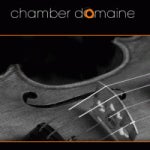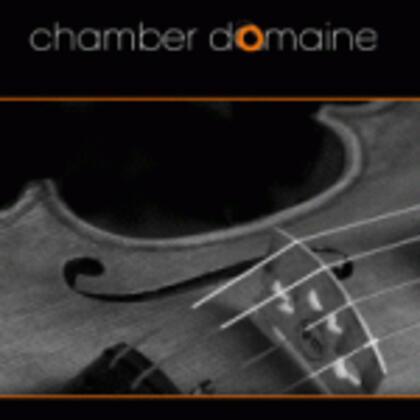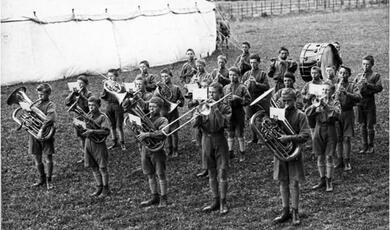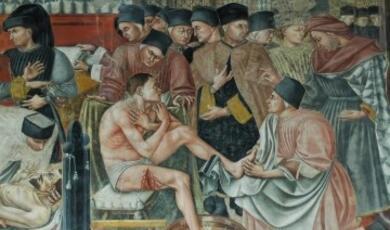Haydn in London: Papa Haydn or genial revolutionary?
Share
- Details
- Text
- Audio
- Downloads
- Extra Reading
This concert looks at Haydn's posthumous reception and his influences on the other composers. Haydn taught Beethoven briefly on his return from London in 1795 and both Mozart and Beethoven dedicated works to him.
In the 19th century, his music was viewed as an earlier and less accomplished version of that by Mozart and Beethoven who were lionized by the Romantics. His music continues to influence and inspire.
The pieces performed were:
George Benjamin - Meditation on Haydn's name
Stravinsky - Suite Italienne for Cello and Piano
Introduzione
Serenata
Aria
Tarantella
Minuetto e Finale
George Benjamin - Flight for Solo Flute
Haydn arr. Salomon - Symphony No.104 "The London"
Adagio/Allegro
Andante
Minuetto I and II
Allegro Spiritoso
The performers were:
Thomas Kemp - Violin
Magnus Johnston - Violin
Nick Barr - Viola
Adrian Bradbury - Cello
Stephen De Pledge - Piano
Sami Junnonen - Flute
2009 marks the 200th anniversary of Haydn's death and this event is part of the series of concerts that puts his fantastic instrumental chamber music and song into its social and cultural context. Each concert will be proceeded by a talk by Thomas Kemp, the artistic director of Chamber Domaine, recently praised in The Guardianfor its "dynamic commitment and high virtuosity. A breath of fresh air."
The other concerts in the series Haydn in London include:
The Enlightenment and Revolution
The Revolutionary Drawing Room
London: The place to be seen and heard
Download Text
HAYDN IN LONDON:
PAPA HAYDN OR GENIAL REVOLUTIONARY?
Chamber Domaine
The main piece on tonight's programme is Haydn's London Symphony, which is actually the final symphony that he composed. On 4th May 1795, Haydn performed this piece, directing from the keyboard, in a concert that was at the King's Theatre on Haymarket. The concert included his last symphonies that he had written, some chamber music, some arias from various cantatas and some other pieces he had written for singers, as well as some pieces with piano and small ensemble. The orchestra contained sixty players and so was quite large for Haydn's music. Haydn, as a result of this concert, earned 4,000 guilders, which he said could only be possible in London. 4,000 guilders may be a meaningless figure to most of us today, but to put it into some kind of context, it represented five or six years of Haydn's salary as a court musician in Esterhazy. In fact, as I said in my last talk, in the first two years that he was in London, he earned more money performing, teaching and playing for the aristocracy, than he earned in 25 years as a court composer in Esterhazy. So London was a very profitable place for him to be, but it was also very interesting place for him to be here at that time. 1795 was just after the French Revolution and there were many people from France and from the Continent - intellectuals and fantastic performers - and Haydn enjoyed himself very much in such company.
This particular piece, the London Symphony, is the last symphony that he wrote, and it represents many of the qualities which were to become hugely influential, particularly in the Twentieth Century. When you listen to the beginning of this symphony, in this particular arrangement by Salomon, who was the impresario that brought Haydn to London in the first place, the very opening has the kind of haughty grandeur of perhaps a French overture, so it sounds like something from the Baroque period, but almost immediately after the start of this rather imposing Baroque opening Haydn starts exploring some of the most remote and beautiful dissonant harmonies. This is very typical of Haydn, because, all the way though his career, one thing that is very consistent was that he was a great experimenter, and I think that probably the biggest achievement of his long life. He was born in 1732 and he died in 1809, which was a long time for someone to be alive in those days, but his inventiveness is remains constant, which is particularly noticeable given that he was always very hard-working and produced an enormous quantity of music on a regular basis to order, from the court in Esterhazy, and also as a freelance composer in Vienna and London. When you look at his music overall and this incredible invention, what you begin to see is that his great achievement lies in the fact that he is really writing music where the form is no longer dictated by the content. In Baroque music, if you have a minuet or a gavotte, the actual structure of the music is dictated by the fact that it is a gavotte, so you have certain rhythmical patterns, certain melodic gestures, certain articulations that belong to that particular formal structure. But with Haydn, what he has achieved by the end of his life, and you will hear it in this symphony, is something where the content actually determines the form of the piece. This is a very radical idea: it means that you can have an idea and you can effectively create music into anything, into something completely different.
This great change in looking at music is something that fits well with the Enlightenment aesthetic and with how the Enlightenment aesthetic then moves into Romanticism. You would think that this would be something that the Romantics would be impressed by, but what actually happened to Haydn is very interesting.
To give you some idea of what a celebrity he was, when he died in 1809, Napoleon sent a group of officers to provide a guard of honour around his house in Vienna. Bearing in mind that the Napoleonic troops were occupying Vienna and so were really the enemy, it really shows how well respected he was and how much of a famous figure in his own day he was. That Napoleon made sure that he sent these troops to provide a guard of honour says a lot about his status as the most eminent composer, and not just the most distinguished in terms of his age and longevity.
But what is interesting about the Romantic era is that it was not so much Haydn that the Romantics were interested in. It was more Beethoven, and this is greatly down to the way that Wagner developed his ideas later on in the Nineteenth Century. For example, Wagner wrote a book about Beethoven's Ninth Symphony and he saw Beethoven as the way that music was going to go and that this was like a new German music. It was very much linked to the idea of the nation state and wrapped up in the romantic ideas of Beethoven being a heroic figure and tragic figure. Haydn was considered a heroic figure, but somehow, he became seen as the kind of elder statesman rather than the visionary composer, and of course, the Romantics idolised Mozart because it is easy to create a myth about someone who was a child protégé, somehow writes the most perfect music, has these demons and dies very young. It was easy for the Romantic ideas to be spun for Mozart, but with Haydn did not fit their mould. He was very hard-working, a great musician, a perfectionist at detail, and so in the 19th Century, his music was seen as rather old-fashioned and slightly plodding. Perhaps it was because many amateur musicians played his quartets badly in their houses, and people just saw it as rather old-hat. But actually, Haydn's legacy is a huge one, and it is largely to do with this enormously long creative life, and the way that he generates forms from the actual content is a very radical concept, and it is one which, without Haydn, Beethoven, and composers after Beethoven, would have struggled. In fact, pieces like Tristan and Isolde would be impossible to compose without having that kind of concept that Haydn invented with, where you come up with an idea and you can spin this idea out for four or five hours into a huge opera. This is Haydn's legacy to the following history of music after this period.
One of the other things that you will hear in the London Symphony is Haydn's incredible use of silence. In fact, there are no composers before Haydn that really used silence as an ironic effect; as an effect to jolt the listener; an effect to kind of get people guessing what was going to happen next. He was the master of this form of suspense and you will hear this in the London Symphony but there are many other examples.
Haydn was also a great one for using asymmetry, coming up with a phrase that does not quite sound right. If you listen to the first minuet of the London Symphony, you will know what I am talking about. You cannot dance to it - you would trip over. This is something that had a huge influence on composers like Stravinsky in the Twentieth Century, particularly after the First World War, where the concept of romanticism and nationalism was no longer a popular idea, and neoclassicism in music, and in other art forms, was to become hugely popular. In fact, one of the interesting things about Stravinsky's own music, if you listen to the Rite of Spring, Petrushka or Firebird, they are essentially an extension of the Romantic idea of the symphony orchestra and the kind of idea of creating music with amazing colours and lots of effects to make very emotive music, and Stravinsky moved away from that style to something much more simple with the Pulcinella Suite. The Suite Italianne, which is later in the programme, on the cello, is actually an arrangement of Pulcinella, and you will hear the use of silence and this idea of generating forms out of little motivic gestures - this is precisely Haydn's legacy.
I have spoken about this in previous talks, but the idea of musical irony really begins with Haydn, and this is something that has a huge history, not only in music, but in all the other art forms, and Haydn really is the very beginning of this. I have mentioned before that Haydn owned copies of Tristram Shandy and The Sentimental Journey, two very radical books by the English author Laurence Sterne. Haydn very much develops ideas from Sterne in his music, such as the idea of taking the listener for a ride, the idea of humour that is only really understood by people that know what is going on, or humour that is very obvious to people as well. There are lots of sudden dynamic changes in his music, which you will hear in the symphony.
In the Twentieth Century, what we might see as the Haydn renaissance, if you like, happened in France. When it was the centenary of his death in 1909, a group of French composers, including Ravel and Debussy, decided to write pieces based on Haydn's name, and it is actually possible to use Haydn's name and turn it into notes, if you pretend that "y" and "n" are musical notes. So you began to see composers, who were very radical and inventive in their own right, looking back to this earlier music. Obviously, with the advent of recording, eventually Haydn's symphonies were recorded, but actually, the complete Haydn editions did not really emerge on record until the 1960s and 1970s, which is really a long time. So they were not particularly popular. Even now, people would rather listen to a Mozart symphony or a Beethoven symphony, but this is not to diminish Haydn's importance as a composer.
The piece that you are going to hear first in the programme is by a British composer called George Benjamin, and this piece was actually written as a homage to Haydn for the 250th anniversary of his birth. This particular piece shows some influence of the idea of generating content from a problem or a knot. In this case, he uses the B-A-D-D-G, Haydn's name in musical notes, and that forms the motivic basis for a short piano piece. Also, you will notice that the ornamentation and some of the rhythmical elements that he uses do not sound too dissimilar from the beginning of the London Symphony where there are these double dotted rhythms.
The flute piece, Flight, which is from 1979, is for unaccompanied flute. This is another example of how Haydn may have influenced Benjamin's thinking. This particular piece is in a rondo form, and Haydn's many finales of his symphonies are in rondo form. This form is where you have an "A" idea, then you have something a bit different, which is the "B" idea, and then you come back to "A" again, and then you might have a "C" idea, and then you come back to "A" again, and you generate a structure that is perhaps like a layered cake of musical ideas. Haydn used this type of finale because it enabled him to have much more material than just having a fugal finale, which, in a lot of the earlier string quartets, he always used as the finale as that was the tradition. But Haydn moves away from that, and what you find in his symphonies is you might have a fugal element at some point in the piece, but the whole movement will not be a fugue. So that is a very good example of using the material to generate the form rather than to write something that has a form already imposed on it by the actual nature of the music.
So in terms of his legacy, there are many aspects of his music that have influenced our thinking, and I think also, one of the things to remember, is that it is not just the music itself that influenced subsequent composers, it is also the ideas that lie behind it, and that is something that is always worth remembering. With people like Haydn and Beethoven, they were very much men of their time. To put Haydn into some kind of context, he started out as a servant but by the end of his working life he was really a master of his own destiny - he was financially independent, he did not need to have to work for a prince or an archbishop - and that is a very radical shift. People often said, when I was at school, that Beethoven was the first composer to achieve that, but actually, it was really Haydn.
This all boils down to one issue, because it was London that enabled Haydn - and Handel too - to become free from the kind of constraints of working for a prince or a duke or a pope or whoever it was that they were working for. This was possible because London was the biggest city in the world at that particular point in time. There was a certain point in the 18thCentury where London was basically the epicentre of all things artistic and all things tasteful.
Just to bring this little talk to a close, one of the interesting facts about Salomon, who arranged the London Symphony for piano quintet, was that this was a commercial enterprise. Salomon, when he brought Haydn over to London, actually owned the rights to these symphonies, so he could do what he wanted with them. He could publish them a thousand times with different publishers. The whole basis of London musical culture, now, as then, was very much based on entrepreneurialism rather than on princely patronage. In fact, the royal family, although they heard Haydn play, were not great patrons of the arts. In fact, the only royal that is really a patron of the arts is Prince Charles, which perhaps is quite true still today. But what Haydn has given us and what his London stay represents are obviously the last symphonies that he wrote, which are called, collectively, the London Symphonies, which are probably his most developed and most radical symphonic creations. But Haydn's stay in London is also significant because he would have had a huge influence on musicians here, and a huge influence on how London was perceived in the rest of Europe as a cultural centre. He played a major role in this really being a golden period for London; this period effectively from Handel through to Haydn's last stay in 1795 was one of the great flowerings of music-making in this country.
I think, to conclude, Haydn is a radical innovative composer, who hides behind a kind of rather haughty, bewigged exterior, but his actual mind and his feeling towards music and his understanding of the human condition is really beautifully depicted in the pieces that you will hear today, particularly the London Symphony.
© Chamber Domaine, Gresham College, 01 April 2009
This event was on Wed, 01 Apr 2009
Support Gresham
Gresham College has offered an outstanding education to the public free of charge for over 400 years. Today, Gresham College plays an important role in fostering a love of learning and a greater understanding of ourselves and the world around us. Your donation will help to widen our reach and to broaden our audience, allowing more people to benefit from a high-quality education from some of the brightest minds.


 Login
Login







